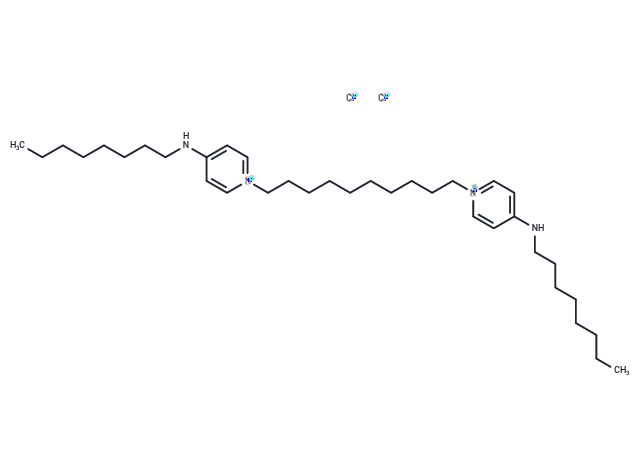Shopping Cart
- Remove All
 Your shopping cart is currently empty
Your shopping cart is currently empty

Octenidine is an antibiosis.

| Pack Size | Price | Availability | Quantity |
|---|---|---|---|
| 100 mg | $35 | In Stock | |
| 200 mg | $50 | In Stock | |
| 1 g | $64 | In Stock |
| Description | Octenidine is an antibiosis. |
| In vitro | Octenidine at concentrations below 1.5 μM (0.94 μg/mL) results in over 99% reduction of the assessed microbial population within 15 minutes. Among the tested organisms, Staphylococcus epidermidis exhibits the highest susceptibility, whereas E. coli and C. Albicans show the lowest susceptibility[1]. |
| In vivo | Octenidine hydrochloride (OCT) demonstrates sustained antimicrobial activity upon application to the skin of cynomolgus monkeys' hands and feet. Aqueous octenidine effectively diminishes resident microflora by 90 to 99.98% at concentrations ranging from 0.2 to 1.6%[1]. Moreover, a significant reduction in plaque score on buccal tooth surfaces was observed following daily topical applications of 1% solutions of octenidine and chlorhexidine for seven days, with octenidine proving to be more effective than chlorhexidine[2]. |
| Kinase Assay | The bactericidal activities of OCT and CHG against Staphylococcus aureus are measured by exposing cultures to several different concentrations of each compound for various lengths of time. OCT is diluted from the 5 mM stock solution and tested in phosphate buffer at levels ranging from 0.5 to 5.0 FsM. The test is begun by adding the bacterial culture to the test solution containing OCT or CHG; samples are taken at 5, 15, 30, and 60 min afterward. The inoculum size is approximately 106 CFU/mL[1]. |
| Molecular Weight | 623.82 |
| Formula | C36H64Cl2N4 |
| Cas No. | 70775-75-6 |
| Smiles | [Cl-].[Cl-].CCCCCCCCNc1cc[n+](CCCCCCCCCC[n+]2ccc(NCCCCCCCC)cc2)cc1 |
| Relative Density. | 1.046 g/cm3 at 20℃ |
| Storage | Powder: -20°C for 3 years | In solvent: -80°C for 1 year | Shipping with blue ice. | |||||||||||||||||||||||||||||||||||
| Solubility Information | DMSO: 6.24 mg/mL (10 mM), Sonication is recommended. H2O: 50 mg/mL (80.15 mM), Sonication is recommended. | |||||||||||||||||||||||||||||||||||
Solution Preparation Table | ||||||||||||||||||||||||||||||||||||
DMSO/H2O
H2O
| ||||||||||||||||||||||||||||||||||||

Copyright © 2015-2025 TargetMol Chemicals Inc. All Rights Reserved.